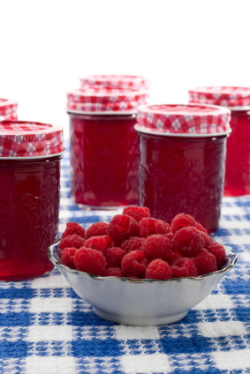 CHERRIES–Good quality cherries, sweet or tart, should be: Firm and shiny–to avoid over-ripeness and over-age. Plump and well-colored to insure ripeness. Free from blemishes or brown circular spots.
CHERRIES–Good quality cherries, sweet or tart, should be: Firm and shiny–to avoid over-ripeness and over-age. Plump and well-colored to insure ripeness. Free from blemishes or brown circular spots.
If stems are off, inspect for decay or broken skin. Those with broken skins spoil quickly.
To can sweet cherries–Wash, stem and pit the cherries, if desired. Wash jars and rinse in hot water. Pack the cherries in hot jars and cover with sirup to within one-half inch from the top of the jar. Prepare sirup by dissolving 1 1/2 parts sugar in two parts water.
Insert a table knife down sides of the jar to remove the air bubbles. Wipe the jar rim with a damp cloth and secure the lids according to the manufacturer’s directions. Place the filled jars in the boiling water bath. Allow three to four inch spaces between jars. Have the water level at least one inch above the tops of the jars. Process for 20 minutes. Start counting time when a rolling boil is reached. Remove from water and cool. Cherries for pies may be canned in water, but keep their color better when some sugar is used.
To freeze, wash, drain, pit or leave the cherries whole. Do not scald. Use a 40 to 60 per cent sirup or four to six parts berries to one of dry sugar.
RASPBERRIES or BLACKBERRIES–Choose berries that are clean, plump, free from caps, and free from green or other off-colors. Sandy berries are almost impossible to clean so you should avoid them. Stained boxes are a sign of over-ripe or crushed fruit. Each berry of any one variety has about the same number of seeds. So, your best buy for flesh and juice are the larger ones.
To can use a cold or raw pack for red raspberries and others which do not hold shape well. Make light or medium sirup. Wash and drain berries. Pour about one-half cup hot sirup into hot jar. Fill jar with berries. Shake jar to pack berries closely without crushing. Add enough sirup to cover berries. Process 20 minutes in boiling water bath.
Use a hot pack for blackberries and others that hold their shape. Wash, drain and measure firm, ripe berries. Put into kettle and add 1/4 to 1/3 cup sugar for each quart berries. Let stand two hours. Cook until sugar dissolves and berries are boiling hot. Pour, hot into hot jars. Add boiling water if there is not enough sirup to cover berries. Process 15 minutes in boiling water bath.
To freeze blackberries and black raspberries pick the berries over, rinse and drain. Pour 1/2 cup medium sirup into container. You do not need to add any acid. Add berries and enough sirup to cover them. Place a piece of crumpled cellophane or parchment paper on the berries. Cap with a tight lid.
For red raspberries rinse a few berries at a time in ice-cold water. Drain and freeze in medium sirup as explained above.
BLUEBERRIES–Choose berries that are plump, whole, dry and have an even, deep blue coloring. Decay is indicated by mold. A dull looking berry is probably over-ripe. A shriveled berry has been picked too long.
To can–These berries may be canned in sirup or water, but this method is better if berries are going to be used in muffins. Put two quarts clean berries in a square of cheesecloth. Hold cloth by the corners and dip into boiling water until spots appear on the cloth. Then dip into cold water. Pack into hot jars. (Add neither sugar nor liquid.) Process 20 minutes in boiling-water bath.
To freeze–scald the berries to prevent the skins from toughening during freezing. To do this place 1 1/2 quarts clean berries in a square of cheesecloth and hold in boiling water for one minute. Chill berries in cold water, drain, pack and freeze as explained for blackberries.
CURRANTS–Choose firm berries that are attached to the stems. Avoid those that are soft, discolored, or mushy. Most of these spicy little berries go into jams and jellies. But, they can be canned by the same method given for raspberries or blackberries.
If you are planning to use your berries fresh rather than canning or freezing them, plan to use them as soon as possible after buying them. They can be kept only about a week with proper storage in the refrigerator. A temperature of 30° to 32° F. and a relative humidity of 85 to 90 per cent is best. Wash just before using. Added moisture before storage will hasten mold and other forms of spoilage.
Source: This is a magazine article from 1959, you can see a scan of most of the article here–it’s been folded a few times and the article is also too large for my scanner but you can see most of it.
 More Recipes For You To Enjoy:
More Recipes For You To Enjoy:



